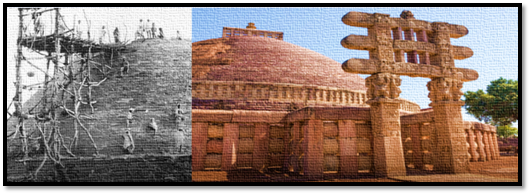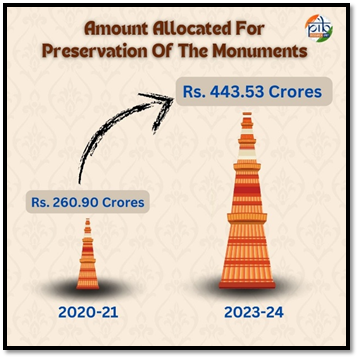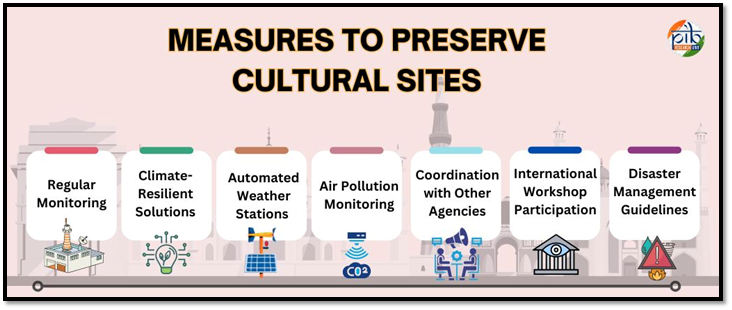Ministry of Culture
Conserving the Immortal Marks of Archaeological Sites
Safeguarding India’s Ancient Wonders
Posted On:
14 FEB 2025 4:53PM by PIB Delhi
“Heritage is not only history. Rather a shared consciousness of humanity. Whenever we look at historical sites, it lifts our mind from the current geo-political factors.”
~Prime Minister Shri Narendra Modi

India, a land of surprises is home to some of the world’s most iconic cultural and archaeological treasures. From the intricately carved temples of Khajuraho and the historic ruins of Hampi to the revered Somnath temple, the country boasts a vast array of monuments that reflect its rich history, diverse traditions and architectural brilliance. These sites stretching from the northern Himalayas to the southern tip of Kanyakumari are a testament to India’s glorious past and cultural legacy.
However, climate change and extreme weather patterns such as rising sea levels, heatwaves, forest fires, torrential rains and strong winds are putting these invaluable landmarks at significant risk. The damage caused by these factors is accelerating the deterioration of both movable and immovable heritage, threatening the preservation of India’s cultural identity. Active intervention is crucial to ensure the preservation of these historical treasures, as their future remains at risk without immediate protective measures.
ASI’s Role in Monument Protection
Established in 1861, the Archaeological Survey of India (ASI) is responsible for protecting and maintaining 3,698 monuments and archaeological sites that are considered of national importance. These sites are protected under the Ancient Monuments Preservation Act of 1904 and the Ancient Monuments and Archaeological Sites and Remains Act of 1958.

ASI preserves a wide range of heritage, including prehistoric rock shelters, Neolithic sites, megalithic burials, rock-cut caves, stupas, temples, churches, mosques, tombs, forts, palaces, and more. These sites reflect India's rich cultural and architectural history.
Each year, ASI prepares a conservation program to maintain and protect these monuments working to minimize intervention while preserving their authenticity. Conservation involves addressing challenges that arise from the nature of construction, materials used, and environmental factors. Decay or deteriorating of protected monuments depends on nature and technique of their construction, material used, structural stability, climate factors, biological, botanical factors, encroachments, pollution, quarrying natural disasters, etc.
ASI tackles these challenges through its 37 Circle offices and 1 Mini Circle office, mainly located in state capitals, where it coordinates conservation efforts and environmental development. The goal is to maintain the integrity of these historical sites for future generations, ensuring they are preserved in their original form and continue to reflect India's heritage.
Significant Increase In Funding

Over the years, the revenue allocated for the preservation of monuments under the Archaeological Survey of India (ASI) has increased by 70%. In 2020-21, the allocation was ₹260.90 crores with an expenditure of ₹260.83 crores, while in 2023-24, both the allocation and expenditure rose to ₹443.53 crores.
Measures to Preserve Cultural Sites from the Adverse Impact of Environment
Under the comprehensive measures, India’s cultural heritage sites are monitored regularly and in order to reduce the impact of climatic change. Archaeological Survey of India (ASI) has been adopting climate-resilient solutions for preservation of cultural heritage sites.
- Regular Monitoring: India’s cultural heritage sites are regularly monitored to protect them from climate change impacts.
- Climate-Resilient Solutions: The Archaeological Survey of India (ASI) is adopting climate-resilient solutions like scientific treatments and preservation techniques for heritage sites.

- AWS Installations: ASI, in collaboration with the Indian Space Research Organisation (ISRO), has set up Automated Weather Stations (AWS) at historical monuments to monitor factors like wind speed, rainfall, temperature, and atmospheric pressure, to detect damage caused by climate change.
- Air Pollution Monitoring: Air Pollution Laboratories have been established at sites like the Taj Mahal in Agra and Bibi Ka Maqbara in Aurangabad to monitor air quality and pollutants.
- Coordination with Other Agencies: ASI holds regular meetings with other government bodies to create coordinated strategies for preserving cultural heritage sites in response to climate change.
- International Workshop Participation: ASI officials participated in an international workshop on "Disaster Management of Cultural Heritage Sites" organized by the National Disaster Management Authority (NDMA) and UNESCO.
- Disaster Management Guidelines: The NDMA, in collaboration with ASI, has developed "National Disaster Management Guidelines" for cultural heritage sites, covering risk assessment, disaster preparedness, and recovery plans.
Legal and Security Measures
The Government has implemented various measures to safeguard cultural heritage from commercialization and urbanization pressures. These include legal provisions, enforcement powers, and enhanced security to ensure the protection of monuments and archaeological sites.
- Legal Protection: Under the Ancient Monuments and Archaeological Sites and Remains Act, 1958, the Government has set rules to protect cultural heritage from encroachments and misuse.
- Encroachment Control: Superintending Archaeologists have the authority to issue eviction notices under the Public Premises (Eviction of Unauthorised Occupants) Act, 1971, to remove encroachments.
- Collaboration with Authorities: ASI coordinates with State Governments and police authorities to assist in removing encroachments and maintaining the safety of monuments.
- Security Measures: In addition to regular watch and ward staff, private security personnel and the CISF are deployed for the protection of select monuments.
- Conservation Guidelines: ASI follows the National Conservation Policy, 2014, for maintaining and conserving monuments, adjusting efforts based on available resources.
- Penalty for Misuse: Section 30 of the Ancient Monuments and Archaeological Sites and Remains Act, 1958, enforces penalties for actions that damage or misuse protected monuments.
With legal frameworks, coordinated efforts, and strict security protocols, the Government is committed to preserving these historical treasures for future generations.
Conclusion
Preserving India's cultural heritage is an ongoing, multifaceted effort requiring proactive measures to address environmental, legal and security challenges. The Archaeological Survey of India (ASI) in collaboration with various agencies continues to monitor, protect and conserve the nation’s monumental treasures. With continued dedication, these efforts ensure that India's rich history remains safeguarded for future generations to experience and appreciate.
References
Click here to download PDF
******
Santosh Kumar/ Sarla Meena/ Kamna Lakaria
(Release ID: 2103241)
Visitor Counter : 3429